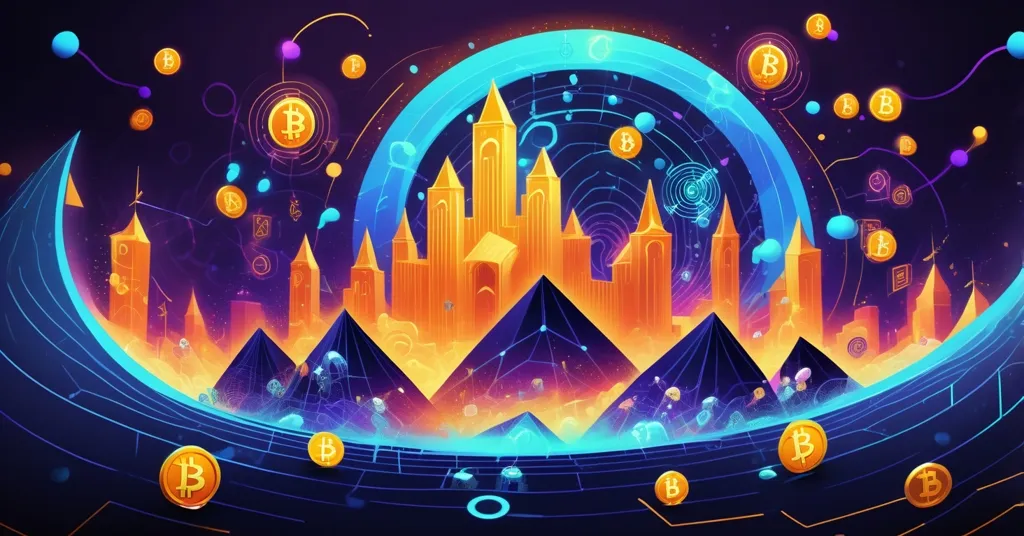3 Cryptos to Watch Over Ripple (XRP): Hidden Gems or Hype Traps?

Top 3 Cryptos to Watch Over Ripple (XRP): Hype or Real Potential?
Ripple (XRP) is up 10% this week, sparking chatter of a climb to $10—but could three underdog cryptocurrencies steal the show with promises of 5x or even 10x gains? Little Pepe (LILPEPE), World Liberty Financial (WLFI), and Aster (ASTER) are being hyped as the next big winners in the current market cycle, potentially outpacing XRP’s rally. Let’s cut through the noise and see if these altcoins are genuine contenders or just another round of speculative fever.
- XRP’s Surge: A 10% weekly gain fuels talk of a $10 target, but is it realistic?
- Altcoin Hype: LILPEPE, WLFI, and ASTER pitched for bigger, faster returns.
- Reality Check: High-risk bets and promotional buzz demand serious skepticism.
Ripple (XRP): Momentum or Mirage?
XRP’s recent 10% weekly uptick has reignited optimism among holders, with some speculating a rally to $10—a staggering 16x jump from its current price of about $0.60 as of late 2023 data. For those new to the scene, XRP is a cryptocurrency built for swift, low-cost cross-border payments, often leveraged by financial institutions through RippleNet. Its price momentum could be tied to ongoing developments in Ripple’s multi-year legal battle with the U.S. Securities and Exchange Commission (SEC), which alleges XRP is an unregistered security. A favorable ruling or settlement could act as a catalyst, as seen in past price spikes like the July 2023 surge after a partial court win. Trading volume has also ticked up, reflecting renewed market interest, though concrete triggers beyond general altcoin momentum remain elusive.
But let’s be brutally honest: a $10 target feels more like wishful thinking than a grounded forecast. Such predictions often stem from social media hype or unverified rumors of partnerships rather than solid fundamentals like adoption metrics or revenue growth. Bitcoin maximalists in our camp might argue XRP’s centralized nature—given Ripple’s control over much of the supply—clashes with the ethos of true decentralization we champion. Still, XRP fills a niche for institutional payments that Bitcoin doesn’t touch, and its steady climb deserves a nod. The question is whether it can sustain momentum against flashier, riskier bets like those highlighted in predictions of cryptos surpassing XRP’s rally.
Little Pepe (LILPEPE): Meme Magic or Madness?
While XRP plays the slow-and-steady game, risk-hungry traders are eyeing wilder prospects like Little Pepe (LILPEPE), a self-styled Layer 2 meme coin. If you’re scratching your head, a Layer 2 is a tech layer added to a main blockchain like Ethereum to make transactions faster and cheaper. LILPEPE markets itself as a speedy, secure chain that fends off sniping bots—those annoying algorithms that prey on token launches for quick profits. With zero buy/sell taxes and near-zero trading fees, it stands out in a meme coin space often riddled with hidden costs. Currently in Stage 13 of its presale at $0.0022 per token (a 120% rise from its starting price), it’s raised over $27.4 million with 16.6 billion tokens sold. The project dangles carrots like a meme-only Launchpad for future token drops, centralized exchange (CEX) listings at $0.003, a CertiK security audit for credibility, and a Mega Giveaway worth over 15 ETH for presale buyers.
On paper, it’s a tantalizing pitch. But let’s not sugarcoat it—meme coins are crypto’s lottery tickets, where the odds of striking gold are dwarfed by the risk of getting burned. For every Dogecoin fairy tale, countless projects like Squid Game token have ended in rug pulls, where developers vanish with investor funds. LILPEPE’s anonymous team (no public info on founders) and heavy reliance on presale hype raise red flags. Sure, a CertiK audit adds a veneer of trust, but audits don’t guarantee against scams or market dumps. Even if legit, can a meme coin on Layer 2 truly disrupt anything, or is this just a fleeting trend? We’re all for effective accelerationism—tech that shakes up the status quo—but gambling on LILPEPE feels more like a roll of the dice than a calculated move.
World Liberty Financial (WLFI): Stablecoin Strength or Speculation?
Next in the spotlight is World Liberty Financial (WLFI), a governance token tied to the USD1 stablecoin ecosystem. If you’re new to this, governance tokens give holders a say in a project’s direction, often in decentralized finance (DeFi) setups. WLFI has jumped over 35% recently, hitting a weekly high of $0.158 according to CoinGecko data. What’s fueling the fire? A blend of political and institutional tailwinds. A proposed $2,000 tariff dividend by former President Trump is cited as a crypto market booster, though its direct link to WLFI is tenuous at best. More intriguing are reports of sovereign funds testing USD1 for cross-border settlements, hinting at real-world utility. If verified, this could position WLFI’s ecosystem as a challenger to traditional banking systems, a niche Bitcoin doesn’t directly serve and one we’re keen to see disrupted.
Yet, let’s pump the brakes hard. Political promises are as reliable as a paper umbrella in a storm, and “testing” by institutions often amounts to nothing more than a press release. WLFI’s surge might reflect market FOMO rather than lasting value, especially since details on USD1’s mechanics or adoption scale are scarce. Compare this to stablecoins like USDT or USDC, which dominate with billions in daily volume—WLFI is a speck in that arena. The upside is real if institutional trust grows, aligning with our push for decentralized alternatives to fiat systems. But betting on WLFI now is like buying a ticket to a show that might never start. Proceed with caution, and don’t let the hype blind you to the risks.
Aster (ASTER): Whale Waves or Warning Signs?
Rounding out the trio is Aster (ASTER), trading around $1.10 with a consolidation range of $0.91 to $1.25 and firm support at $1.00. The buzz here centers on whale accumulation—big players buying up huge chunks of tokens. Since early November, whales have reportedly scooped up 51 million tokens worth about $53 million, often a sign of an impending rally. For the uninitiated, whales are like the heavyweights of a small market, capable of shifting prices with their moves, sometimes based on insider info or strategic plays. Analysts are tossing out predictions of a 5x to 10x return during the next altcoin surge, per CoinGecko insights.
That sounds juicy, but let’s not get carried away. Whale activity is a double-edged sword—they might build up to pump the price, only to dump their holdings at the peak, leaving retail investors stranded. What’s more damning is the lack of clarity on Aster’s purpose. Is it a payment token, a DeFi play, or something else? Without a transparent use case or roadmap, this smells like pure speculation. Historical flops like BitConnect remind us that hype without substance often ends in tears. We love seeing new projects push boundaries, but Aster’s whale-driven narrative feels more like a casino bet than a step toward decentralization. If you’re tempted, keep your stake small and your skepticism high.
Bitcoin’s Shadow: Why BTC Still Reigns
As Bitcoin maximalists at heart, we can’t ignore the elephant in the room: none of these altcoins match BTC’s proven track record for security, decentralization, and store-of-value status. While XRP, LILPEPE, WLFI, and ASTER chase speculative gains, Bitcoin remains the bedrock of financial freedom and privacy—core tenets we live by. Altcoins often fill niches Bitcoin doesn’t, like meme culture or institutional payments, and we’re not blind to their experimental value in driving effective accelerationism. But when the dust settles on hype cycles, BTC’s unmatched network effect and resilience typically outshine the flash-in-the-pan promises of lesser-known tokens. If you’re new to crypto, starting with Bitcoin might be the sanest move before dipping toes into these riskier waters.
The Dark Side: Scams, Volatility, and Regulatory Hammers
Let’s lay it bare—crypto isn’t all rainbows and moonshots. The space is crawling with scams, and projects like these three carry glaring red flags: anonymous teams (looking at you, LILPEPE), vague roadmaps (ASTER, we’re watching), and overreliance on external hype (WLFI’s political ties). Add to that the market’s brutal volatility—where a 35% gain can turn into a 50% loss overnight—and you’ve got a recipe for financial pain. Regulatory risks loom large too. XRP’s SEC saga is just one example; WLFI’s institutional links could draw scrutiny if stablecoins face tighter rules, as hinted by recent U.S. policy debates. We’re champions of disrupting the status quo, but not at the cost of ignoring the pitfalls. If you’re playing this game, spot the warning signs: aggressive marketing, unrealistic promises, and lack of transparency. Don’t let FOMO turn you into a cautionary tale.
Key Takeaways and Burning Questions
- What’s driving Ripple (XRP)’s 10% weekly gain and $10 price speculation?
A mix of market sentiment and potential progress in Ripple’s SEC lawsuit fuels the buzz, though hard evidence for a $10 target is thin, leaning on hope over data. - Why are Little Pepe, WLFI, and Aster hyped over XRP for bigger gains?
Their unique angles—meme coin innovation, stablecoin adoption, and whale activity—promise quicker, larger returns compared to XRP’s gradual climb. - Is Little Pepe (LILPEPE) a genuine contender or just meme coin fluff?
Its Layer 2 tech and CertiK audit offer some legitimacy, but the meme coin arena’s scam history and anonymous team scream high risk. - How do political and institutional factors boost WLFI’s 35% surge?
Trump’s proposed tariff dividend and sovereign fund testing of USD1 spark interest, but such external drivers are shaky for long-term value. - Does whale accumulation mean Aster is set for a breakout?
It suggests big-player confidence, but whales can dump holdings anytime, risking heavy losses for smaller investors caught off guard. - Can investors trust these wild price predictions for altcoins?
Hardly—most 5x or 10x forecasts are baseless hype meant to spark FOMO, not guide smart choices. Do your own digging. - How does Bitcoin stack up against these speculative altcoins?
BTC’s security and decentralization tower over altcoin gambles, making it a safer anchor while altcoins experiment in niche areas. - What red flags should crypto enthusiasts watch for in new projects?
Look out for anonymous teams, vague use cases, and overblown marketing—hallmarks of potential scams or pump-and-dumps.
The Bottom Line
The crypto battlefield is littered with both groundbreaking ideas and opportunistic traps. Ripple (XRP) might have steady momentum, but its $10 dream feels more like a long shot than a sure thing. Little Pepe, WLFI, and Aster bring bold narratives to the table, potentially outpacing XRP in raw percentage gains—if they don’t implode first. We’re passionate about decentralization and accelerating tech that upends outdated systems, but blind optimism isn’t our style. Bitcoin remains the gold standard for freedom and privacy, while altcoins play their part in testing new frontiers. If you’re tempted by these high-flyers, tread lightly, research relentlessly, and never bet more than you can afford to lose. The revolution is worth fighting for, but not at the expense of your wallet or wits. Stay sharp out there.



